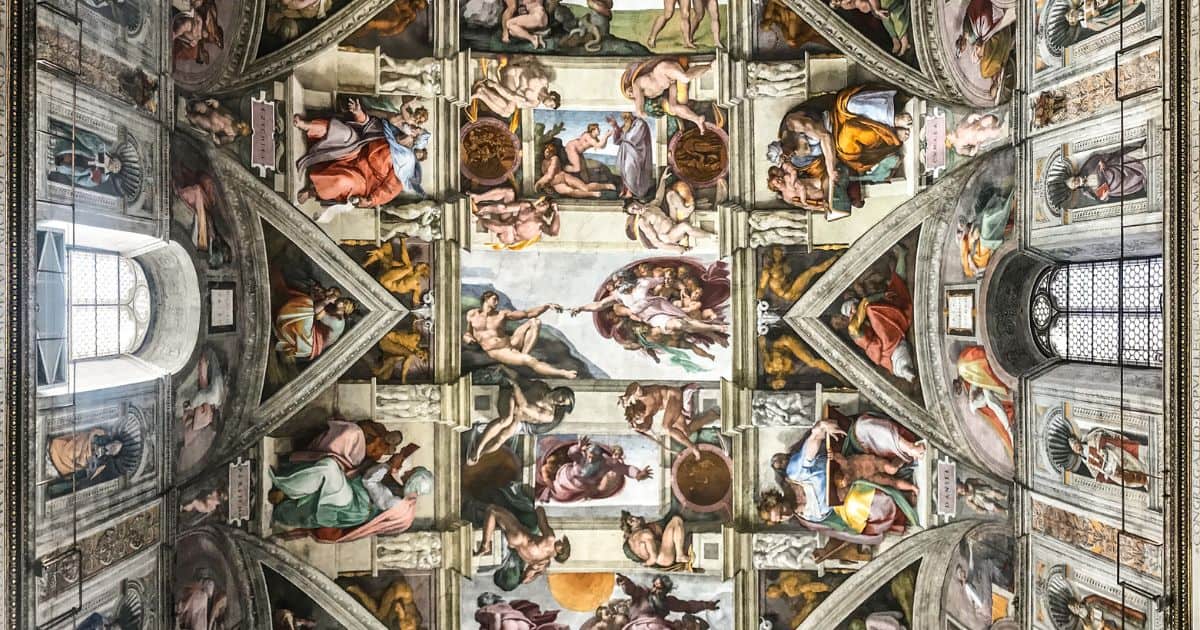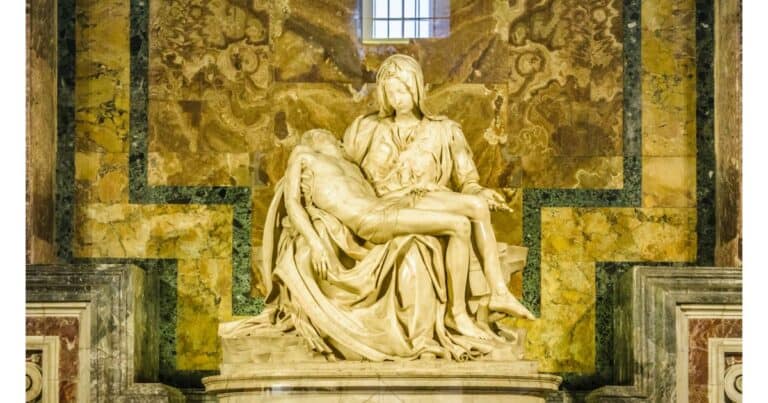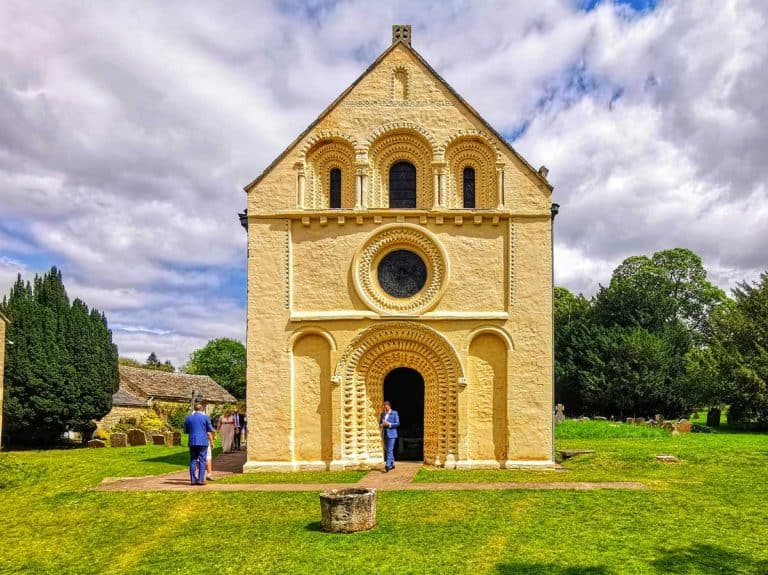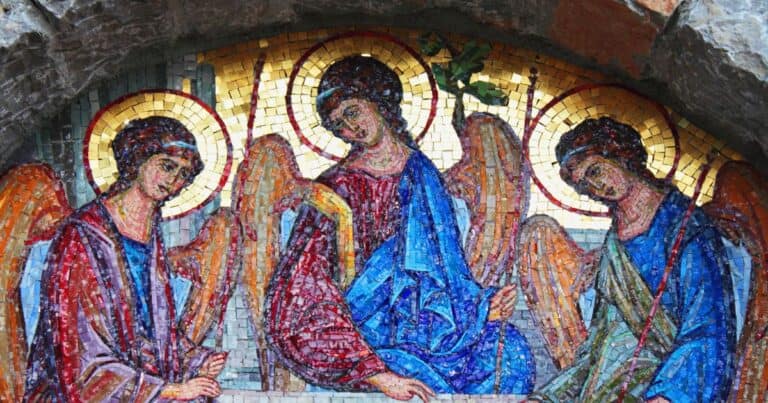Under the Divine Canopy: A Voyage Through Famous Christian Art
Welcome to the world of famous Christian art, a realm where faith and creativity intersect in profound and moving ways. This world spans centuries and continents, reflecting the diverse ways in which artists have sought to express the Christian narrative.
Christian art has long been recognized as a significant marker of civilization. From the early catacombs of Rome to the awe-inspiring Sistine Chapel, from Byzantine icons to the stained glass of Chartres, Christian art has left an indelible mark on our culture and history.
In this blog post, we’ll journey through the rich tapestry of famous Christian art. We’ll explore the stories behind the art, the historical contexts that shaped them, and their enduring influence on our collective imagination.
The Genesis of Christian Art
In exploring famous Christian art, we’ll step into this vast cathedral of creativity, ready to appreciate its depth and diversity. As we do, we’ll gain a deeper understanding of the power of art to express the divine and inspire the human spirit.
In the early centuries of Christianity, the faith was still finding its footing in a world dominated by Roman and Greek religions. Much like the faith itself, the art of this era was modest yet profound, symbolic yet evocative.
The early Christians, often persecuted for their faith, used art as a secret language to express their beliefs and tell their stories. They adorned the walls of catacombs – underground burial places – with simple yet powerful symbols. The fish, the anchor, and the dove were not random images but coded messages of faith, hope, and love.

Photo courtesy of Fernando de Gorocica , CC BY-SA 4.0, via Wikimedia Commons
Early Christian art was significantly influenced by the Roman world’s artistic traditions, as Encyclopedia Britannica noted. Early Christian artists adopted and reinterpreted the symbolic vocabulary of Roman art to express their faith. This marked the beginning of a unique tradition in Christian art, which would continue to evolve over the centuries.
As Christianity became more accepted, artists began to depict scenes from the Bible and images of Christ and the saints more literally. This significant development showed that Christians were no longer afraid to openly express their faith through art.
The shift from symbolic to figurative art was a major development in the history of Christian art. It allowed artists to communicate Christian ideas in a more direct and accessible way, and it helped to solidify Christianity’s place in the Roman Empire.
Christian Art in the Byzantine Era
As we move forward in time, we arrive at the Byzantine era, a period marked by the fusion of Roman, Greek, and Christian cultures. This fusion gave birth to a unique artistic style that would leave a lasting impact on famous Christian art.
Byzantine art is often characterized by its use of rich colors, intricate patterns, and a distinct sense of spirituality. The artists of this era were not just creating art; they were creating windows to the divine. Their works were meant to inspire awe, to evoke a sense of the sacred, and to serve as aids in worship.
Byzantine Icons Blend Art and Spirituality
One of the most iconic forms of Byzantine art is the icon. These were not just paintings, but sacred objects of veneration. These small, sacred paintings depicted Christ, the Virgin Mary, saints, and angels, often against a gold background that symbolized the divine light.
The flat, two-dimensional style of these icons, adorned with gold leaf, might seem simple at first glance. But behind this simplicity lies a profound spiritual depth. Icons were not just objects of beauty; they were tools for worship, revered as a means to connect with the divine.
In the Byzantine Empire, creating icons was not just an artistic endeavor but a spiritual discipline. Iconographers, trained in specialized schools, adhered to a strict set of rules to ensure their creations accurately represented the holy figures they depicted.
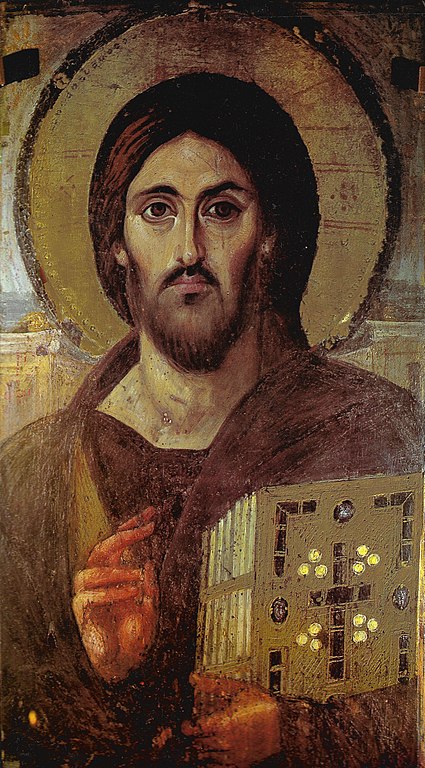
Saint Catherine’s Monastery in Egypt, home to the largest historical collection of Christian icons, houses the renowned Christ Pantocrator, an icon depicting Christ as the universe’s ruler. The icon is distinguished by its hieratic style and gold leaf embellishments.
Other important Byzantine icons are the Virgin of Vladimir and Theotokos Hodegetria, revered works that resonate with Orthodox Christians today, underscoring Byzantine iconography’s enduring appeal.


Mosaics of Ravenna
To illustrate the rich tradition of Byzantine art, we can also look at the Mosaics of Ravenna, a UNESCO World Heritage Site. These mosaics, which were created in the 5th and 6th centuries, depict scenes from the Bible, images of Christ, and portraits of saints. The mosaics are highly realistic and detailed, and they show a mastery of perspective and shading.
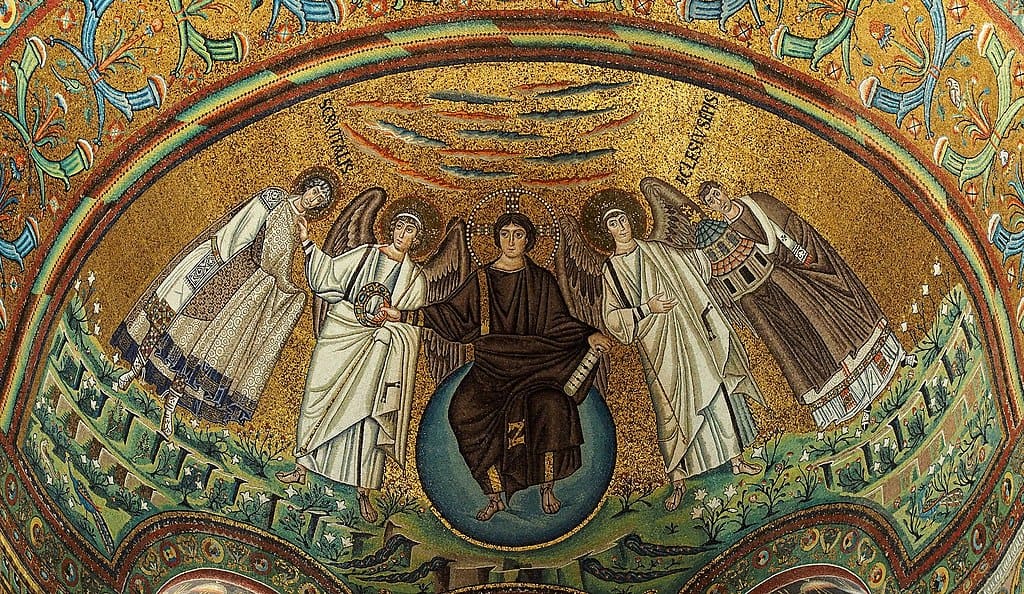
(Photo courtesy of Petar Milošević, Basilica of San Vitale, CC BY-SA 4.0 via Wikimedia Commons.)
The city of Ravenna was the capital of the Western Roman Empire from 402 to 476, and it remained an important city in the Byzantine Empire for centuries. The mosaics were commissioned by the Byzantine emperors and the local rulers, and they were created by some of the most talented artists of the time.
The mosaics of Ravenna are found in several different churches and buildings in the city, including the Basilica of San Vitale, the Mausoleum of Galla Placidia, and the Apsidal Chapel of the Archiepiscopal Palace. These mosaics are a testament to the artistic and religious achievements of the Byzantine Empire, and they continue to be admired by visitors from all over the world.
The Byzantine era was a time of great creativity and innovation in Christian art. But it was also a time of controversy. The use of icons in worship led to the Iconoclast Controversy, a fierce debate that divided the Byzantine Empire for over a century. This controversy, while disruptive, also highlighted the importance and power of art in the Christian faith.
You may also enjoy reading: Roofless Church
Christian Art in the Middle Ages
The Middle Ages, a period spanning from the 5th to the 15th century, was a time of profound development in Christian art. This era gave birth to some of the most famous Christian art pieces, including remarkable paintings that continue to captivate audiences today.
During the medieval period, Christian art was deeply woven into the societal fabric, serving as a tool for education, a symbol of the Church’s power, and a source of spiritual inspiration. Art became a visual language, narrating biblical stories and conveying religious ideals to the largely illiterate population.
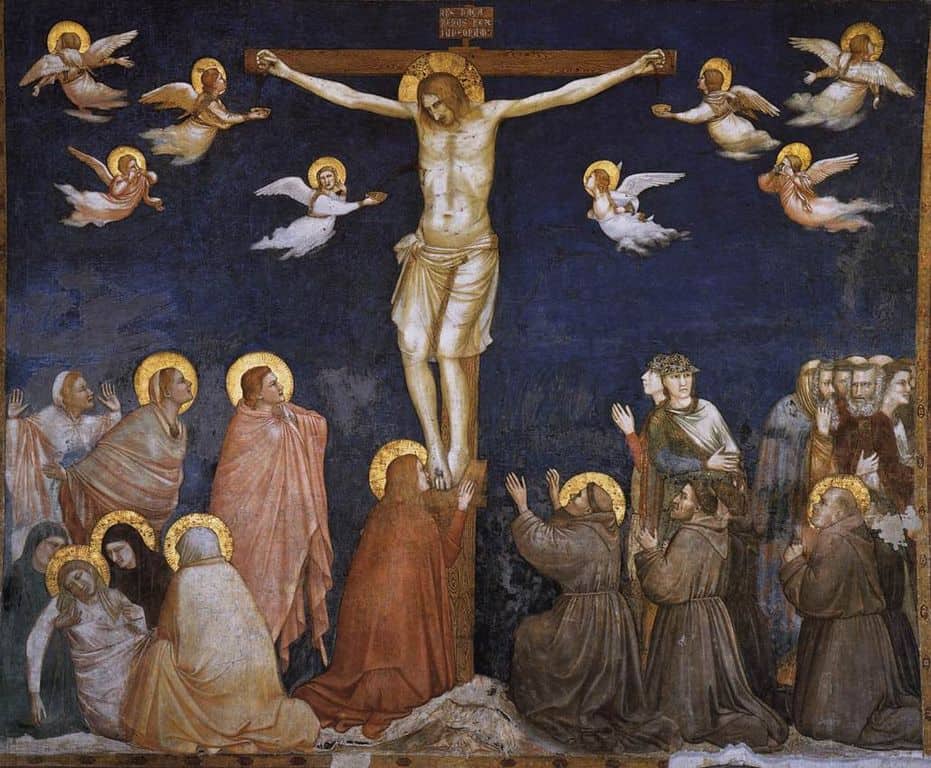
One of the most renowned examples of medieval Christian art is the frescoes in the Basilica of San Francesco d’Assisi in Italy. These frescoes, attributed to the artist Giotto di Bondone, depict scenes from the life of St. Francis of Assisi.
Giotto’s innovative use of naturalism and emotion in these frescoes marked a significant departure from the stylized Byzantine art, paving the way for the artistic revolution of the Renaissance.
Another iconic example of medieval Christian art is the Ghent Altarpiece, also known as “The Adoration of the Mystic Lamb,” painted by the brothers Hubert and Jan van Eyck. This complex polyptych altarpiece, renowned for its detailed realism and innovative use of oil paint, is one of the most influential paintings in Western art.
Despite a history fraught with theft and damage, the Ghent Altarpiece, a masterpiece of Christian art, has been meticulously restored by an international team, thanks to the Getty Foundation’s Panel Paintings Initiative. Now, through a digital platform, this iconic work can be studied globally, offering unparalleled access to its intricate details.
Faith and Art in the Renaissance
The Renaissance, a period of cultural rebirth from the 14th to the 17th century, brought about a profound transformation in famous Christian art. This era, marked by a renewed interest in classical knowledge and a deep fascination with the human experience, gave rise to some of history’s most celebrated works of art.
Christian themes continued to dominate the art of this period, but how these themes were depicted underwent a significant change. Artists began to use more realistic representations, a greater emphasis on human emotion, and a newfound focus on perspective and light. These changes were not just stylistic; they reflected a broader shift in how people understood their relationship with the divine.
One of the most iconic paintings of this era is Leonardo da Vinci’s “The Last Supper.” This mural, painted in the late 15th century, depicts the moment Jesus announces that one of his disciples will betray him. Da Vinci’s masterful use of perspective, attention to detail, and ability to capture the emotional intensity of the scene have made “The Last Supper” a cornerstone of famous Christian art.

(Leonardo da Vinci, Public domain, via Wikimedia Commons)
Another masterpiece of Renaissance Christian art is Michelangelo’s “The Creation of Adam,” part of the Sistine Chapel’s ceiling frescoes. This painting, with its dynamic composition and profound symbolism, captures the moment of divine creation with unparalleled drama and grandeur.
Another masterpiece of Renaissance Christian art is Michelangelo’s “The Creation of Adam,” part of the Sistine Chapel’s ceiling frescoes. This painting, with its dynamic composition and profound symbolism, captures the moment of divine creation with unparalleled drama and grandeur.
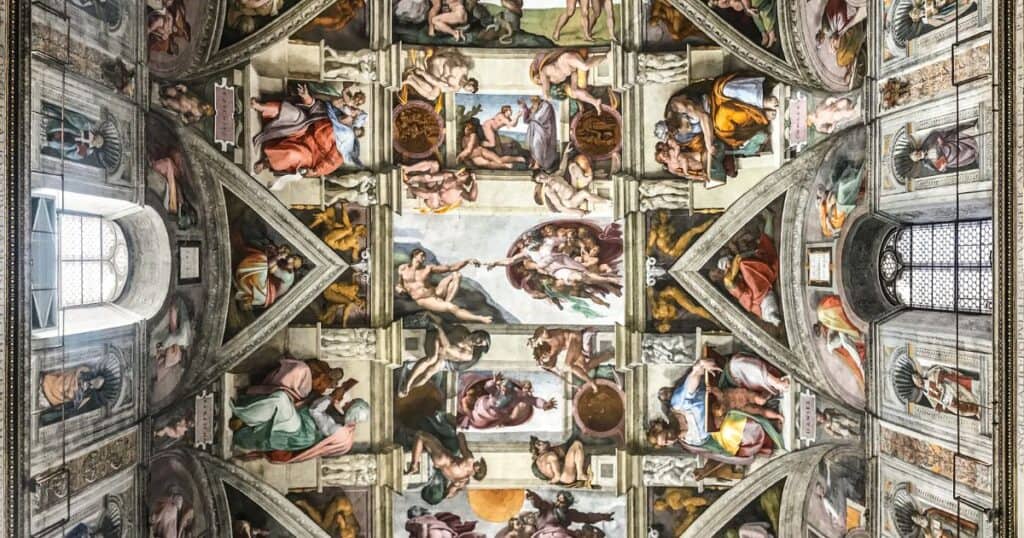
Christian Art in the Contemporary World
As we move into the modern era, from the 19th century to the present, we see a continued evolution in famous Christian art. This period is characterized by diverse styles, themes, and interpretations, reflecting the complex and often turbulent times in which the art was created.
In the modern era, Christian art began to explore new forms and mediums. Artists started experimenting with abstract representations, symbolic imagery, and unconventional materials. These changes were driven by a desire to express personal faith, to critique or question religious institutions, and to engage with contemporary social and political issues.
One notable example of modern Christian art is Salvador Dali’s “The Sacrament of the Last Supper.” This painting, with its surrealistic elements and innovative use of perspective, offers a unique interpretation of the biblical scene. Dali’s work, while controversial, has made a significant contribution to famous Christian art, challenging traditional norms and pushing the boundaries of artistic expression.
The Influence of Christian Art in Popular Culture
Christian art, while rooted in religious tradition, has always had a broader cultural impact. From films and books to music and public spaces, elements of Christian art can be found in many aspects of popular culture.
This influence is not just about the use of Christian themes or symbols. It’s also about how Christian art has shaped our aesthetic sensibilities, storytelling traditions, and cultural values. Whether it’s a biblical epic on the silver screen, a spiritual hymn on the radio, or a mural in a public park, the influence of famous Christian art is pervasive and enduring.
Final Thoughts
Our journey through the world of famous Christian art has taken us from the early catacombs of Rome to the modern art galleries of New York, from the solemn icons of Byzantium to the vibrant frescoes of the Sistine Chapel. Along the way, we’ve seen how Christian art has evolved and diversified, reflecting the changing times and the enduring power of faith.
Famous Christian art is not just about beautiful paintings or stunning architecture. It’s about the human quest for meaning, the expression of spiritual beliefs, and the celebration of artistic creativity. It’s a testament to the power of art to inspire, challenge, and transcend the boundaries of time and culture.
Frequently Asked Questions
What is Christian Art?
Christian art refers to works depicting themes, figures, or stories from Christianity. It includes various mediums such as painting, sculpture, architecture, and more. Christian art has a rich history, from the early days of Christianity to the present day.
What are some examples of famous Christian art?
Famous Christian art includes works like Leonardo da Vinci’s “The Last Supper,” Michelangelo’s “The Creation of Adam,” and Salvador Dali’s “The Sacrament of the Last Supper.” Other examples include the Byzantine icons, the Book of Kells, and the stained glass windows of Chartres Cathedral.
How has Christian art changed over time?
Christian art has evolved significantly over the centuries. Early Christian art was largely symbolic, with artists using simple images to convey Christian themes. Over time, Christian art became more figurative and complex, reflecting religious, cultural, and artistic changes.
What is the role of Christian art in society?
Christian art plays several roles in society. It serves as a form of religious expression, a means of educating people about Christian stories and beliefs, and a source of inspiration and comfort. Christian art also has a broader cultural impact, influencing our aesthetic sensibilities, storytelling traditions, and public spaces.
Where can I see famous Christian art?
Famous Christian art can be found everywhere, from churches and museums to public parks and online collections. The best places to see Christian art include the Vatican Museums, the Metropolitan Museum of Art, and the National Gallery. Many works of Christian art are also available to view online through platforms like the Google Art Project.
How can I learn more about Christian art?
Many resources are available for those who wish to learn more about Christian art. These include books, documentaries, online courses, and museum exhibits.

Teresa Trumbly Lamsam, Ph.D., is an accomplished Social Scientist and Journalist. Passionate about establishing credibility in the digital realm, she champions transparent and trustworthy online content. She is dedicated to producing content that sparks curiosity and nourishes the heart and mind.

